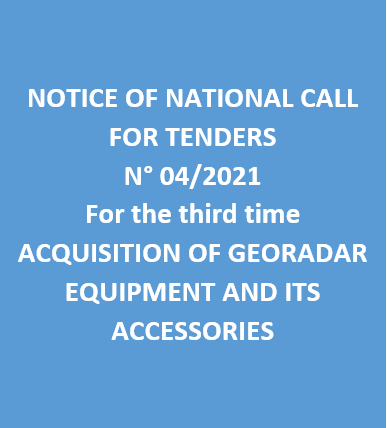| Annual program and technical progress report |
-

Activity Report 2023
-

Technical Program 2024
|
| Geocatalogue |

|
| Invitation to
tender |
-

REALIZATION OF THE TRAINING PLAN FOR THE YEAR 2022
-

ACQUISITION OF TWO SERVICE CARS
-

ACQUISITION OF GEORADAR EQUIPMENT AND ITS ACCESSORIES
|
|
Invest in Tunisia |

|
|
|
|
|
::
Documentation and Editions
>>
Research library
|
| |
|
[
Search by author
]
[
Search keyword
]
[
Search by index
]
[
Search by category
]
|
title of the reference :
|
Mineralogy and geochemistry of smectitic clays of Gafsa areas (south of Tunisia) and their industrial applications.
|
|
Publication Date:
|
1992
|
|
Author :
|
Jamoussi Fakher, Srasra Ezzedine
|
|
Catalogue type :
|
Livre
|
|
Catalogue reference :
|
Vol.XXXV-A (ITA) Miner. Petrogr. Acta Vol.XXXV-A Mineralogy and geochemistry of smectitic clays of Gafsa areas (south of Tunisia) and their industrial applications. The physical and chemical characterization of several clay deposits in the Gafsa area is conducted in order to test the bleaching capacity of clays. Clays occur in the middle member of the Abiod formation (Upper Campanian-Lower Maestrichtian)and the El Haria formation (Lower Maestrichtian-Paleocene). These clays are studied by X-ray diffraction (XRD), infrared sprectroscopy (IR), chemical analysis, granulometry and gravimetric (GTA)and differential thermal analysis (DTA). Clays of the jebel Orbata, jebel Es Stah and jebel Sehib, comprise Ca-smectites (40 to 65 ), illite (1 to 3), kaolinite (3 to 12 ) and other minerals such as calcite (7 to 34 ), quartz (6 to 17 ), gypsum (0 to 5 ) and dolomite (1 to 16 ). After their identification, these clays are activated by HCl or H2SO4 upon varying times for the bleaching experiences. The results obtained for the bleaching with clays of used mineral oil and plant oil show interesting results similar to those obtained with commercial bleaching clay. bibliogr. argile substance ; absorbant ; hydrocarbure ; utilisation industrielle ; analyse ; smectite ; Tunisie ; Tunisie Sud Occidentale ; Gafsa ; O. Ksab ; J. Orbata ; O. Labaied ; O. Tfal ; J. es Stah ; O. Djej ; J. Sehib ; O. Kharoubet Srasra Ezzedine Jamoussi Fakher Minéralogie
|
|
Indexation decimale :
|
Minéralogie
|
|
Keywords :
|
argile substance ; absorbant ; hydrocarbure ; utilisation industrielle ; analyse ; smectite ; Tunisie ; Tunisie Sud Occidentale ; Gafsa ; O. Ksab ; J. Orbata ; O. Labaied ; O. Tfal ; J. es Stah ; O. Djej ; J. Sehib ; O. Kharoubet
|
|
Summary :
|
The physical and chemical characterization of several clay deposits in the Gafsa area is conducted in order to test the bleaching capacity of clays. Clays occur in the middle member of the Abiod formation (Upper Campanian-Lower Maestrichtian)and the El Haria formation (Lower Maestrichtian-Paleocene). These clays are studied by X-ray diffraction (XRD), infrared sprectroscopy (IR), chemical analysis, granulometry and gravimetric (GTA)and differential thermal analysis (DTA). Clays of the jebel Orbata, jebel Es Stah and jebel Sehib, comprise Ca-smectites (40 to 65 ), illite (1 to 3), kaolinite (3 to 12 ) and other minerals such as calcite (7 to 34 ), quartz (6 to 17 ), gypsum (0 to 5 ) and dolomite (1 to 16 ). After their identification, these clays are activated by HCl or H2SO4 upon varying times for the bleaching experiences. The results obtained for the bleaching with clays of used mineral oil and plant oil show interesting results similar to those obtained with commercial bleaching clay.
|
|
Exemplaries :
|
TU1724
|
|
|
|
|
|
|
|



